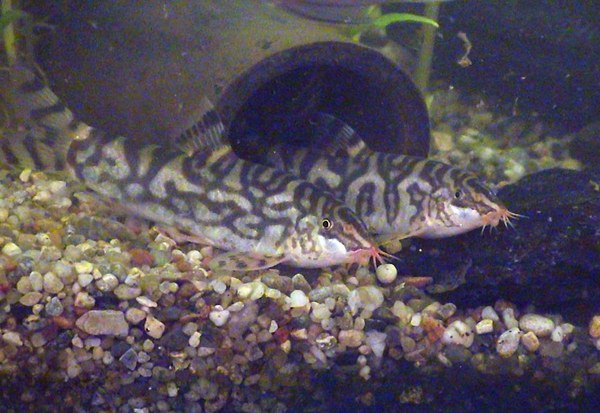Sexual Dimorphism & Courtship Behaviour in Botia almorhae
A combination of several authors entries on this species.
by Hans Beiderbeck
23rd August, 1999
Female:
- Body and head in the adult with a number of irregular brown cross bands generally three Y-shaped bands, the first in front of dorsal, second below dorsal, third behind, bands becoming confluent enclosing variously shaped yellow spots with age.
- All the fins with more or less regular cross bands, generally dorsal, anal and pectoral with three, ventral with two and caudal with four or five.
Male:
- Body and head of adult reticulated with gray on a yellow background.
- All fins with more or less regular cross bands, generally dorsal with three, ventral with two or three, pectoral and caudal with three to five.
Young:
- Bands on body form Y-shaped arches, four or five in number,
passing over large size vertical bands.
- An external sexual dimorphism is also apparent in the length of the snout, that of the female is distinctly longer.

Bogdan J. Janiczak
April 23rd & 30th, 2001
- The photos of Botia almorhae below show
clearly sexual dimorphism in this species.
- Some nice reddish coloration of males snout (mouth) and edges of the pectoral fins.
- Much more
rounded belly and longer snout of females.
The fish portrayed are about 16 month old and have been purchased as 3cm long offspring. Now, they are approximately 10cm long and are still growing (but already quite slowly).
 |
| Two males. Note red colouring around mouth. |
 |
| A single male. |
 |
| Another male. |
 |
| A female. Note rounded belly |
 |
| An immature female. |
Karsten Plesner
I'm pretty sure that I've seen some breeding behavior in my Botia almorhae. I keep them in a tank with two pairs of Betta pugnax, which breed about once every three weeks. Once when they did this, a pair of the loaches seemed to go nuts. One of them got very light colors and they were swimming in tight circles around each other. A little while later they even took up position very close to each other and began shaking/vibrating. I've seen similar behavior in some Tetras, and I'm sure it's related to breeding. The behavior was most obvious following very large water changes, but part of the behavior can be observed from time to time, and apparently always while the Bettas breed.
I'm sure that this behavior is triggered by the hormones released into the water by the breeding Bettas.
This is just a guess, but maybe the increase in hormones (produced by the breeding Betta pugnax), which is larger in a 'clean' tank than in a tank where the Betta pugnax have bred before, is the reason why the loaches don't show all parts of this behavior each time the Bettas breed. I might be able to make them behave like this again next time I observe the Bettas breeding following a major water change. At least I intend to try.
Regards,
Karsten Plesner

Document Actions

